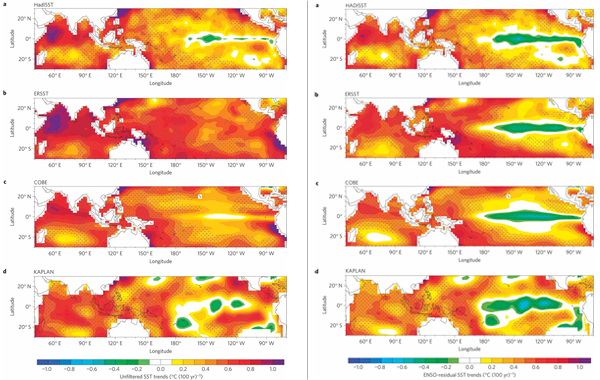Taking the 'Noise' out of Ocean Temperature Trends
Removing El Niño and La Niña to understand climate's effects on ocean temperatures

Scientists are eager to understand what climate change is doing to ocean temperatures — because temperatures in some regions, especially in the tropical Indo-Pacific Ocean, can influence weather and climate around the globe. It's been difficult to find trends in all the "noise" caused by other, non-externally forced climate change related effects — one of the biggest being the El Niño Southern Oscillation, ENSO.
Researchers at the NOAA/ESRL Physical Sciences Laboratory developed a way to remove this noise from records. Their findings, published in the September 2012 issue of Nature Climate Change, show the tropical Pacific cooling in the east, while it warms in the west. These results challenge a fairly widespread scientific assumption that the Walker Circulation–an atmospheric circulation pattern in the tropical Pacific used for centuries by ships to cross the ocean–is weakening.
"Using surface level pressure and sea surface temperature, we don't see evidence of weakening over the past 111 years," said Amy Solomon, a researcher from the Cooperative Institute for Research in Environmental Sciences (CIRES) working at PSL.
A strong Walker Circulation pattern means faster ship west-to-east passage across the tropical Pacific, and it can also mean more upwelling off the coasts of Peru and Ecuador. Upwelling pulls nutrient-rich cold water up to the surface and increases fishing stocks.
There are a number of competing theories about how greenhouse gases may influence ocean temperatures, and, therefore, our climate. To better understand the possibilities, scientists have reconstructed sea surface temperatures (SSTs) across some regions of the Indian and Pacific Oceans back to 1890. A number of these reconstructions identify very similar warming trends. However, in the tropical Pacific region where ENSO brews, these analyses show surprisingly different results.

Even in the case of perfect reconstructions, a random number of ENSO events over a century can produce spurious long-term trends in tropical Pacific Ocean temperatures that are essentially unpredictable. These trends due to natural variability can be large enough to overwhelm the change in SSTs due to an increase in greenhouse gases. In addition, different techniques used to reconstruct ENSO variability since 1890 can produce uncertainties that are larger than spurious trends produced naturally by ENSO. This can blur both long-term trends caused by natural variations, and long-term trends caused by increased greenhouse gases.
"We needed to be able to isolate the trends that are due to ENSO variability in order to see the impact of greenhouse gases," said Solomon.
Solomon and co-author Matt Newman, also of CIRES and PSL, tackled this issue by comparing four different SST reconstructions (left panel in figure) and developing a method to isolate ENSO variability that is represented in each analysis. They reconstructed SST variations due to ENSO for the years 1900-2010 using a statistical technique called linear inverse modeling (LIM). LIM was developed several years ago at ESRL and has been shown to be able to reproduce the behavior of an ENSO event as it evolves over time. After removing the "noise" in the long-term trends caused by ENSO variability, a consistent pattern became clear — and not exactly the one they expected. Although the four reconstructions are accompanied by warming in the western Pacific, the analyses with the noise taken out all showed a systematic cooling in the tropical Pacific (green areas in right panel of figure). This indicates that in the absence of ENSO there has not been a prevalent warming trend in that region, and thus that the Walker Circulation has not weakened.
"We think this is a more accurate estimate of long-term trends in the tropical Indo-Pacific," said Solomon, "which we can use to validate simulations of the historical period in climate models used for projections of climate change."
Additionally, just as ENSO complicates our understanding of past trends in the tropical Indo-Pacific Ocean, so too can it complicate our predictions of future trends there.
"Whatever the trend due to increasing Greenhouse gases will be, it is quite possible that over the next fifty or so years it will be swamped in the eastern Pacific by a spurious trend due to the random occurrence of El Niños over that entire period," said Newman. "Determining where and how ENSO affects the tropical Pacific trend allows us to begin to understand how to predict the corresponding regional precipitation trends."
By Barb DeLuisi, Summer 2012